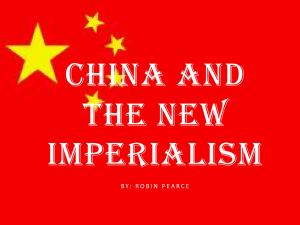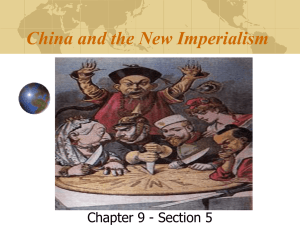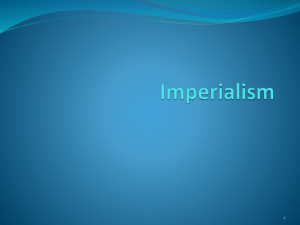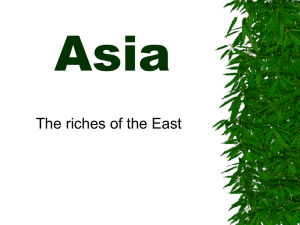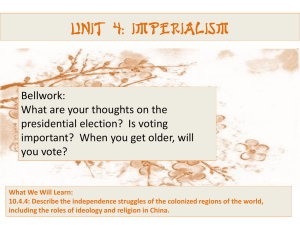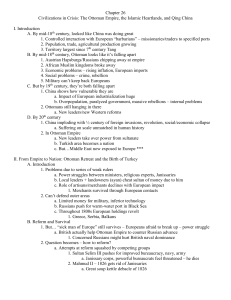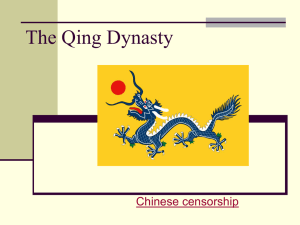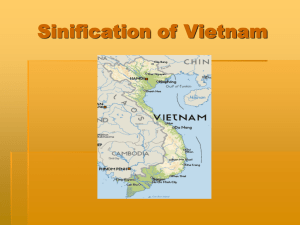Chapter 12 PPT - Mrs. Thiessen`s Social Studies Classes
advertisement
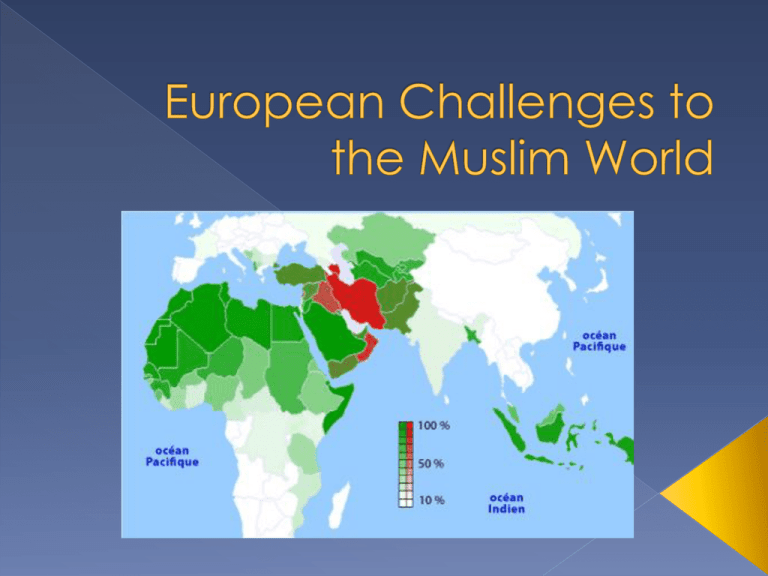
Extended from western Africa to Southeast Asia › The Three Muslim empires: the Mughals in India Ottomans in the Middle East, Safavids in Iran › By the 1700s, these empires were declining, why?? They faced western imperialism › The Europeans demanded for special rights for Europeans living in Muslim lands “The powder keg” › Internal: nationalist revolts weakened the Ottoman Empire › External: European nations tried to gain territory in the Ottoman Empire With westernization, some things improved in the Muslim world › Improved education, trained military and built railroads Nationalism created tensions between Turkish nationalists and minorities who sought their own state › These tensions triggered a genocide of the Armenians Genocide is a deliberate attempt to destroy an entire religious or ethnic group › Over the next 25 years, a million or more Armenians in the Ottoman Empire were killed Iran was ruled by the Safavids and later the Qajars from 1794-1925 Like the Ottoman Empire, Iran faced major challenges in the 1800s Both Russia and Britain battled for influence in Iran › Each nation set up its own sphere of influence in Iran › Both Russia and Britain wanted control of Iran’s oil fields Persuaded the Iranian government to grant them concessions (special economic rights given to foreign powers) Muhammad Ali › Governor of Egypt in 1805 Called “Father of modern Egypt” › Introduced political and economic reforms Strengthened and trained the military Able to conquer Arabia, Syria, and Sudan › His successors were not great leaders Egypt became a protectorate of Britain Suez Canal › A French entrepreneur Ferdinand de Lesseps organized a company to build the Suez Canal A manmade waterway that links the Mediterranean and Red Seas. The British allowed the British East India Company, who won trading rights in India and by 1800s, to control India › Introduced British education and legal procedures › Tried to convert Indians to Christianity › Worked to end slavery and the caste system › Required the use of sepoys (Indian soldiers) Issued new rifles to the sepoys that had cartridges greased with pig fat (against the Muslim religion) Angry sepoys rose up against the British officers The British crushed the revolt › In 1858, Parliament ended the rule of the East India Company and put India directly under the rule of the British crown After 1858, Parliament set up a system of colonial rule in India › A British viceroy in India governed in the name of the queen › The British foreigners worked in government and trade › Upper-class Indians served the lowest government jobs Benefits of British rule The British built roads and railroads to improve trade and transportation. › After the opening of the Suez Canal, British trade with India soared. Transformed agriculture Negatives of British rule › No roles for most Indians in government › Indian Nationalism rose in the 1900s dramatically, and leaders demanded independence During the late 1700s, British merchant began making profits by trading opium grown in India for Chinese tea › Many Chinese became addicted to the drug › Chinese government outlawed opium and executed Chinese drug dealers › The British refused to stop the trade In 1839, Chinese warships clashed with British merchants, triggering the Opium War Chinese were easily defeated In 1842, Britain made China accept the Treaty of Nanjing › Britain received a huge indemnity (payment for losses in the Opium War) › Britain also gained control of the island of Hong Kong › China had to open five ports to foreign trade and grant British citizens in China extraterritoriality Extraterritoriality: the right to live under their own laws and be tried in their own courts The Qing dynasty was in decline by the 1800s The Taiping Rebellion › As poverty and misery increased, peasants rebelled. Lasted from1850-1864 Most devastating peasant revolt in history › Their leader was Hong Xiuquan Hong endorsed social ideas Called for the end of the Qing Dynasty Won control over large parts of China Nearly toppled the Qing Dynasty Caused 20-30 million Chinese deaths In the 1860s, reformers launched the “self-strengthening movement” to westernize China Imported western technology, setting up factories to make modern weapons Sino-Japanese War › Japan modernized after 1868 and began competing with imperialists In 1894, Japanese pressure on China led to the Sino-Japanese War Japan won the island of Taiwan Exposed the difference between modern Japan and China Boxer Uprising › Anti-foreign feeling finally exploded in the Boxer Uprising in 1899 A group of Chinese had formed a secret society, the Righteous Harmonious Fists (Westerners called them Boxers) › The Boxers attacked foreigners across China In response, the western powers and Japan organized a multinational force to crush the Boxers After the Boxer Uprising, the Chinese admitted westernization Although the Boxer rebellion failed, Chinese nationalism grew › Reformers want to strengthen China’s government By the 1900s, they introduced a constitutional monarchy Sun Yixian › In the early 1900s, he organized the Revolutionary Alliance Wanted a Chinese republic In 1908, a two-year old boy inherited the throne and China slipped into chaos › In December 1911, Sun Yixian became president of the new Chinese republic
